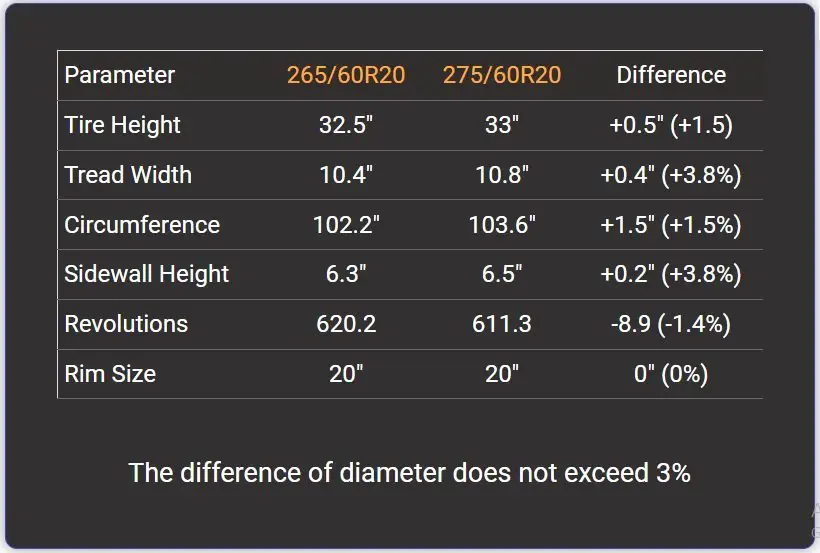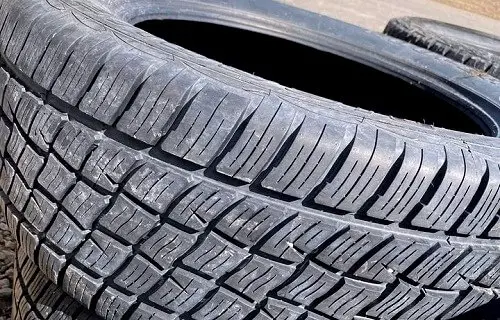Tire Size 265/60r20 vs 275/60r20

Switching from 265/60r20 to 275/60r20 tires involves a slight increase in both width and diameter. The 275/60r20 is marginally larger, offering a 3.8% increase in width and a 1.5% increase in diameter.
This change can affect various aspects of your vehicle’s performance, aesthetics, and handling characteristics, albeit in subtle ways. Let’s dive into the details of what this switch means for your ride.
- 275/60r20 tires are 0.39 inches (10mm) wider than 265/60r20 tires.
- The diameter increases by 0.47 inches (12mm) with the switch to 275/60r20.
- Ground clearance improves by approximately 0.24 inches (6mm).
- Speedometer accuracy is affected, showing a 1.4% decrease in speed.
- The change falls within the acceptable 3% diameter difference for fitment.
265/60r20 vs 275/60r20 Table
The main difference between these two tire sizes is the width. The 275/60r20 tire is 0.39 inch (10mm) wider than the 265/60r20 tire. This will result in a slightly wider stance and improved handling.

Fitment Guide
The general rule of thumb is that replacement tires should be within 3% of the original tire’s overall diameter. In this case, the diameter difference is approximately 1.5%, which falls well within the acceptable range.
Therefore, the interchange from 265/60r20 to 275/60r20 is generally recommended without necessitating significant adaptations to prevent issues such as rubbing or clearance problems.
On-Road Impact
Switching to 275/60r20 tires can have several effects on your vehicle’s on-road performance:
Ground Clearance
The increase in diameter by 0.47 inches (12mm) results in a slight boost in ground clearance. While this may seem minimal, it can make a difference when navigating over small obstacles or uneven terrain, particularly in urban environments with speed bumps or potholes.

Gas Mileage
The larger 275/60r20 tires may have a minor impact on fuel efficiency. The increased width and diameter can lead to slightly higher rolling resistance, potentially decreasing gas mileage by a small margin.
However, the difference is often negligible in real-world driving conditions, and most drivers are unlikely to notice a significant change in their fuel consumption.
Aesthetics
The wider profile of the 275/60r20 tires can give your vehicle a more aggressive and robust appearance. This subtle change in wheel well filling can enhance the overall look of your ride, especially if you’re aiming for a more muscular aesthetic.
The increased width, while not dramatic, can contribute to a more planted and substantial visual presence on the road.
Ride Comfort
The switch to 275/60r20 tires might result in a marginally smoother ride due to the increased sidewall height.
The additional 0.24 inches (6mm) of sidewall can provide a bit more cushioning, potentially absorbing road imperfections more effectively. This could translate to a slightly more comfortable ride, particularly on rougher road surfaces.

Speedometer Accuracy
One of the more noticeable impacts of switching to 275/60r20 tires is on speedometer accuracy. Due to the larger diameter, your vehicle will actually be traveling slightly faster than what the speedometer indicates.
At a speedometer reading of 20 mph (32.19 km/h), your actual speed will be about 20.29 mph (32.65 km/h).
While this 1.4% difference may seem small, it’s worth keeping in mind, especially when it comes to adhering to speed limits or during long-distance travel where the discrepancy can accumulate.
Handling
The wider footprint of the 275/60r20 tires can potentially improve cornering stability and overall grip on dry surfaces. The increased contact patch may offer better traction during acceleration and braking.
However, the taller sidewall might introduce a slight increase in body roll during sharp turns, which could be noticeable to more discerning drivers or in high-performance driving situations.

Off-Road Impact
For those who occasionally venture off the beaten path, the switch to 275/60r20 tires can offer some benefits:
Traction
The wider tread of the 275/60r20 tires provides a larger contact patch with the ground, which can translate to improved traction in various off-road conditions, including mud, sand, and loose gravel. This can be particularly beneficial for light off-road use or in adverse weather conditions.
Ground Clearance
As mentioned earlier, the slight increase in diameter offers a modest boost in ground clearance. While 0.24 inches (6mm) may not seem significant, it can make a difference when navigating over small rocks, shallow ruts, or uneven terrain. This extra clearance can provide a bit more confidence in light off-road situations.
Durability & Wear
The larger size of the 275/60r20 tires might contribute to slightly improved durability in off-road situations. The additional rubber can provide more protection against punctures and cuts from sharp objects encountered on trails.
However, the difference in durability between the two sizes is likely to be minimal and may not be noticeable in typical use scenarios.
Our Observation
Switching from 265/60r20 to 275/60r20 tires offers a blend of subtle improvements and minor trade-offs. The wider footprint and increased diameter can enhance traction, aesthetics, and light off-road capability, albeit marginally.
On-road performance sees slight changes in handling characteristics and a minor impact on fuel efficiency, though these differences are often imperceptible to the average driver. The most noticeable effect is on speedometer accuracy, which requires driver awareness.
Off-road enthusiasts may appreciate the modest boost in ground clearance and potentially improved traction, but the benefits are relatively small for serious off-road use.
It’s important to note that many of these differences, both on and off-road, are quite subtle and may not significantly alter the overall driving experience for most users.
The decision to switch should be based on specific needs and preferences, keeping in mind that the benefits, while present, are generally modest and may only be appreciated by those particularly attuned to their vehicle’s performance.
Can I Replace 275/60r20 With 265/60r20 Tires?
Yes, you can replace 275/60r20 tires with 265/60r20 tires. The diameter difference between these two tires is only 1.5%, within the recommended 3% threshold.
Using tires that closely match the original diameter helps maintain proper vehicle handling and performance. Ensure the load capacity matches or exceeds the original 275/60r20 tires.
How Much Taller Is A 275/60r20 Tire Than 265/60r20?
A 275/60r20 tire is 0.47 inches (12 mm) taller than a 265/60r20 tire, representing a 1.5% increase in diameter.
The specific height of a 275/60r20 tire is 32.99 inches (838 mm), while a 265/60r20 tire stands at 32.52 inches (826 mm).
How Much Wider Is A 275/60r20 Tire Than A 265/60r20?
A 275/60r20 tire is 0.39 inches (10 mm) wider than a 265/60r20 tire, representing a 3.8% increase in width.
The specific width of a 275/60r20 tire is 10.83 inches (275 mm), while a 265/60r20 tire measures 10.43 inches (265 mm).

Meet Caitlin McCormack, a Tire Size Expert and Blogger Passionate About Everything Related to Tires. With Years of Experience in the Tire Industry, Caitlin Has Become an Expert in Tire Sizes and Their Impact on Vehicle Performance.
